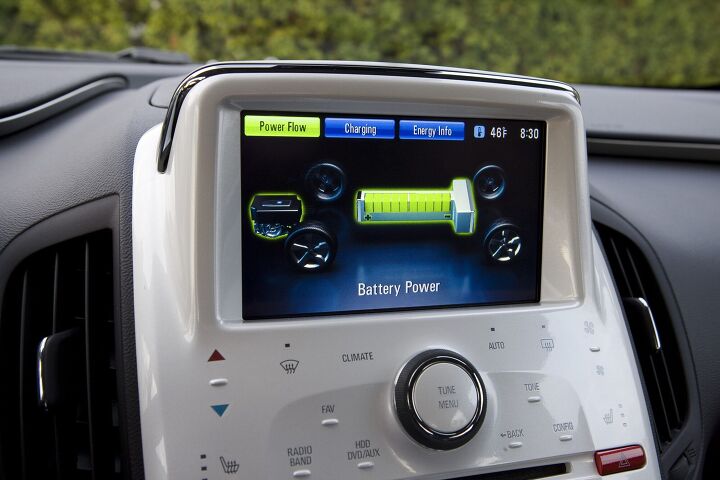Top Tips for Buying a Used Chevrolet Volt

It’s been years since the original Chevrolet Volt hit the market, providing shoppers with exceptional fuel efficiency enabled by its award-winning VOLTEC propulsion system.
The Chevrolet Volt has sold thousands of copies since its launch for model-year 2011. Today, you’ll find many of these on offer in the used marketplace.
Whether you’re looking at a used Chevrolet Volt as a nearly fuel-free primary car or a thrifty second family runabout, you’ll find a wide range of feature content, a versatile interior with room for four, and the possibility of virtually fuel-free driving — depending on your locale, driving habits, and the availability of nearby recharging infrastructure
ALSO SEE: Chevrolet Volt Reportedly Exiting Production in 2022
Below, we’ve compiled a list of advisable pre-purchase checks and inspections for first-generation used Chevrolet Volt shoppers. Consider the following before you buy to help ensure you wind up with a top-notch unit that’s not concealing any potentially pricey problems. Take this list with you as you as a reference when visiting potential second-hand Volt candidates.
A Pre-Purchase Inspection is Mandatory
We’ll put the most important point first: used Volt shoppers should consider a Pre-Purchase Inspection (PPI) at a Chevrolet dealer to be absolutely mandatory as a final step before agreeing to purchase. This inspection should take about an hour, likely cost about $100, and may require you to book an appointment with the dealer service department a few days in advance.
Whether buying privately or from a car lot, see if the seller will let you bring the vehicle to the nearest dealer yourself, meet you there, or drop it off and pick it up for you. Many used car dealers can arrange staff to drop off and pick up a vehicle for a PPI upon request. The best practice is typically to ask the dealer performing the PPI for some appointment options, and then ask the seller which works best for them.
Remember that a PPI by a trained technician is your single best defense against buying a used Volt that’s waiting to turn your wallet inside out.
Inspect All Charging Provisions
The charging cord and associated provisions should be inspected fully before you buy. As the Volt you’re considering could be up to 8 years old, these parts could be showing signs of wear. Cracked or damaged plugs and worn or frayed charge cords can be a safety hazard, and these parts can be pricey to replace. Scrutinize all charging provisions and call any excessive wear into your pricing negotiations.
Inspect the Charge Door
As the Volt ages, some owners report trouble with the charge door, which opens to reveal the electrical charging port. Shoppers are advised to confirm that the release button opens the charge door several times on their test drive. Triple-checking to see if a “CHARGE DOOR OPEN” message is present in the cluster, even if the door is closed, is also a great idea. Either of these conditions can indicate the need for some servicing or lubrication of the charge door mechanism or the need for revised or replacement parts.
Software Updates
A variety of software updates may be available to address or prevent issues with numerous vehicle systems on the Volt you’re considering. Running the most current system software can prevent headaches, improve fuel economy, improve drivetrain refinement, or even prevent your Bluetooth connection from going wonky.
A software update may also be required in the rare occurrence that the Volt’s central command system seems frozen or non-responsive. Talk to your nearest Chevrolet dealer to see if any software updates may be applicable to the Volt you’re considering. They should be able to look up any outstanding software updates quickly if you provide the vehicle’s VIN number. You’ll want to have these applied as soon as possible to prevent potential headaches.
Beware a Whining Sound
Some owners have described a high-pitched noise, similar to a band saw, that could signal an issue with a bearing in the Volt’s driveline, which can be pricey to address.
Listen closely for this sound by turning off the stereo and climate control fan for some portion of your test drive. The sound will likely come from the area near your feet. Operate the Volt at light, moderate and heavy throttle, and while decelerating in both DRIVE and LOW gear ranges. If you detect the whining sound (which is typically loud enough to be intrusive) make arrangements for further investigation by a technician.
Check the Air Conditioner
Several factors may cause the Volt’s air conditioner to perform poorly, or fail outright. These include a low battery charge, use of more economical drive modes, or refrigerant leaks within the system.
ALSO SEE: Next Chevy Bolt EV Reportedly Not Coming Until 2025
Note that failure of past owners to replace the cabin air regularly may dramatically reduce the effectiveness of the air conditioner, or cause outright system failure. Don’t underestimate how few owners actually service their cabin air filters, to the negative effect of climate control system performance.
If poor air conditioner performance is noted, start by assessing the condition of the cabin air filter. If it’s clogged badly, this is the likely culprit. If not, professional attention is required.
Watch your Cranium
Open the Volt’s hatch fully and apply a slight downwards tug with your hand. If the hatch isn’t keen to stay open on its own, or slams shut with minimal force applied, you’ll want to look into a safety recall issued by GM. This recall upgraded the rear hatch struts to a stronger design which could prevent you from taking sheetmetal to the cranium. Recall work is carried out at no charge by dealerships, though you’ll likely need to book an appointment ahead of time.
Battery Concerns
All batteries have a lifespan and will diminish in capacity over time. Largely, the online Volt owner community says that battery degradation has not been an issue thus far. Volt seems to have experienced few if any problems on this front, especially when compared to total sales volume.
With a lengthy battery warranty offered from the factory and numerous advanced control strategies aimed at prolonging battery life, shoppers seem to have little to worry about.
This article originally appeared on HybridCars.com

Justin Pritchard, an award-winning automotive journalist based in Sudbury, Ontario, is known for his comprehensive automotive reviews and discoveries. As a presenter, photographer, videographer, and technical writer, Justin shares his insights weekly through various Canadian television programs, print, and online publications. In 2023, Justin celebrated a significant milestone, airing the 600th episode of his TV program, AutoPilot. Currently, he contributes to autoTRADER.ca, Sharp Magazine, and MoneySense Magazine. His work as a technical writer, videographer, presenter, and producer has been recognized with numerous awards, including the 2019 AJAC Video Journalism Award and the 2018 AJAC Journalist of the Year. Justin holds a Bachelor of Commerce (Hons) from Laurentian University, which he earned in 2005. His career in automotive journalism began that same year at Auto123.com. Since then, he has written one of the largest collections of used car buyer guides on the internet. His passion for photography, nurtured from a young age, is evident in his work, capturing the scenic beauty of Northern Ontario. Living in a region with a particularly harsh winter climate has made Justin an expert on winter driving, winter tires, and extreme-weather safety. Justin’s significant achievements include: 2019 AJAC Video Journalism Award (Winner) 2019 AJAC Road Safety Journalism Award (Runner-Up) 2019 AJAC Automotive Writing (vehicle review topics) (Winner) 2019 AJAC Automotive Writing (technical topics) (Winner) 2018 AJAC Journalist of the Year You can follow Justin’s work on Instagram @mr2pritch and YouTube @JustinPritchard.
More by Justin Pritchard




































Comments
Join the conversation